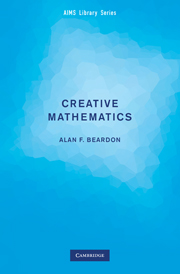17 - Problem B: Discussion and Generalisations
Published online by Cambridge University Press: 16 May 2024
Summary
First, we consider how many digits a(bc) has. An integer N has d digits if and only if 10d−1 ≤N <10d or, equivalently, log10N <d ≤ 1 + log10 N. Thus N has d digits, where d is the integer part of 1 + log10 N. In particular, a(bc) has d digits, where d is the integer part of 1 + (bc) log10 a. For example, 6(66) has 36306 digits.
In Part III we found the sequence of last digits of the towers of x when x = 0, 1, … , 9, and we did this without using any significant results from number theory. However, the more mathematics we know, the more likely we are to make progress. Since the basic problem is to find the numbers xn (mod 10), the following theorem (with m1 = 2 and m2 = 5) is bound to be useful.
Theorem (The Chinese Remainder Theorem) Suppose that m1 and m2 are coprime. Then, for any u and v, the simultaneous congruences x ≡ u (mod m1) and x ≡ v (mod m2) have a unique solution x(u, v) modulo m1m2.
We shall take m1 = 2 and m2 = 5, and require that u ϵ ﹛0, 1﹜, v ϵ ﹛0, 1, 2, 3, 4﹜ and x(u, v) ϵ ﹛0, 1, … , 9﹜. Then x(u, v) is given in the following tabular form:
For example, the column with entries 1, 2 and 7 shows that if u = 1 and v = 2 then x(u, v) = 7. Equivalently, this shows that, for any integer x, if x ≡ 1 (mod 2) and x ≡ 2 (mod 5), then x ≡ 7 (mod 10). In effect, this result reduces the problem to finding u and v, where
xn ≡ u (mod 2),
xn ≡ v (mod 5),
for then x(u, v) is the last digit of xn.
In fact, we have already solved the first of these congruences. We know that for every n, xn is odd or even according as x is odd or even so that, for all x and all n,
- Type
- Chapter
- Information
- Creative MathematicsA Gateway to Research, pp. 75 - 78Publisher: Cambridge University PressPrint publication year: 2009

